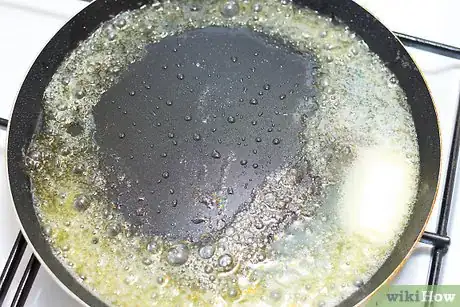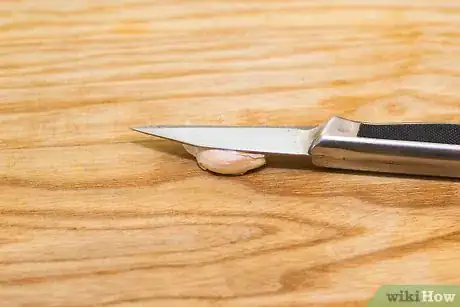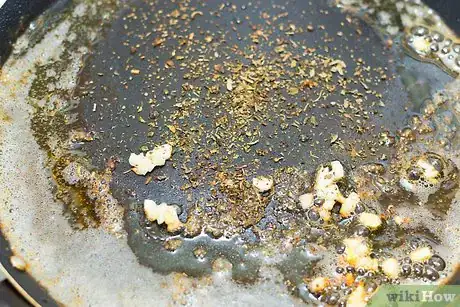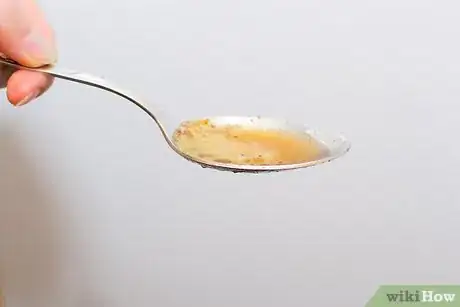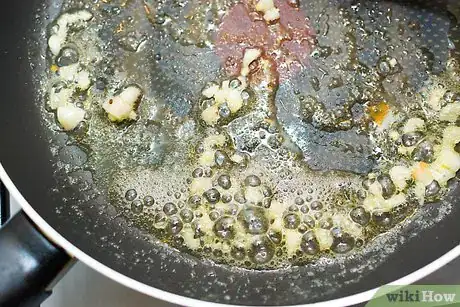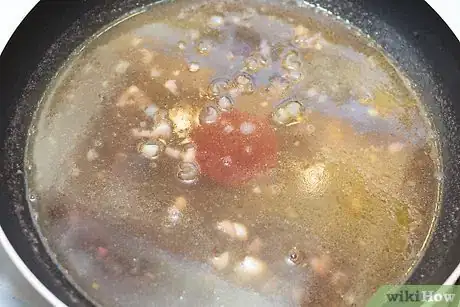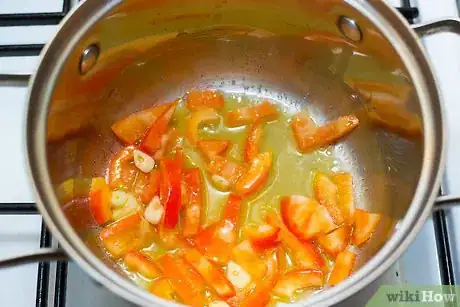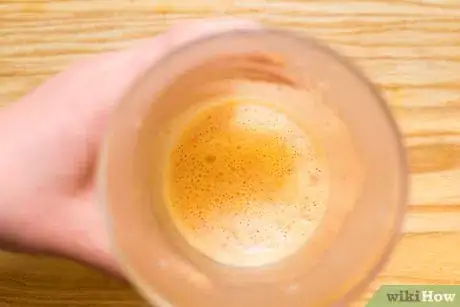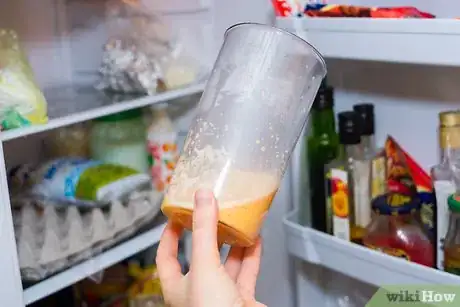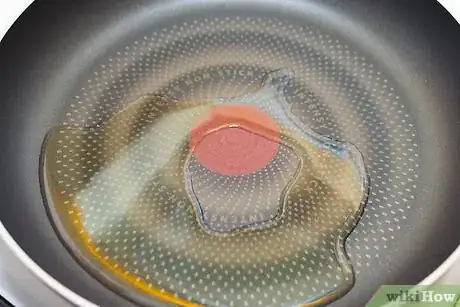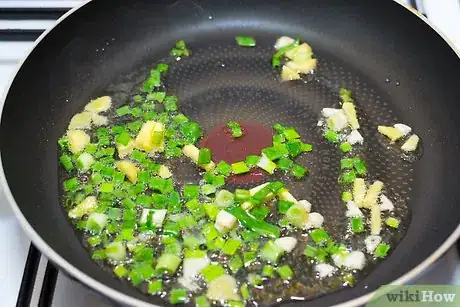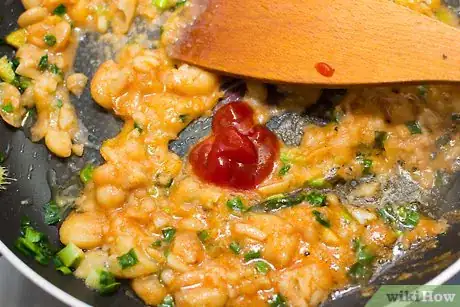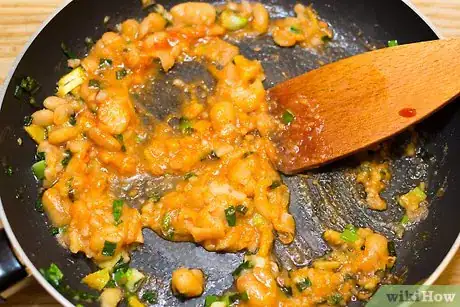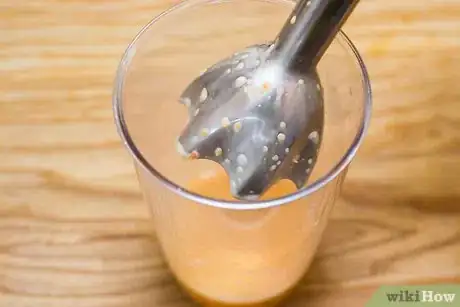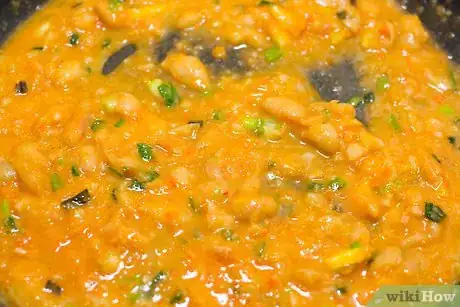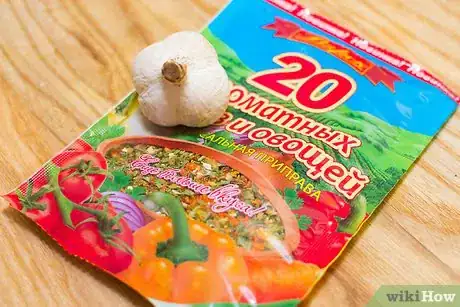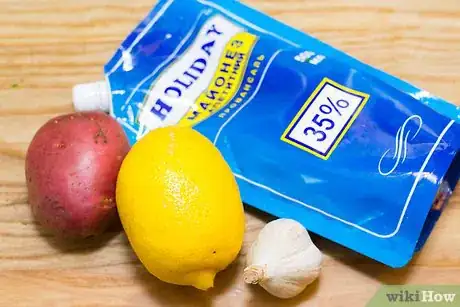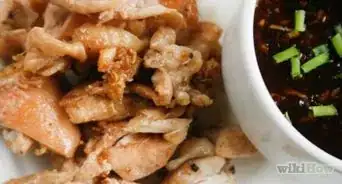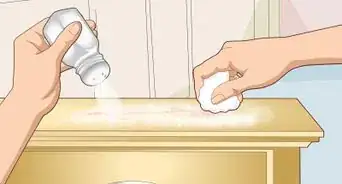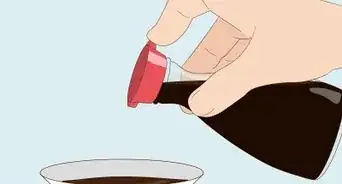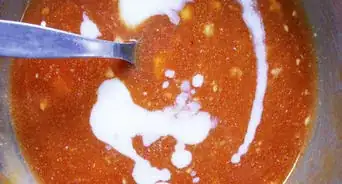wikiHow is a “wiki,” similar to Wikipedia, which means that many of our articles are co-written by multiple authors. To create this article, volunteer authors worked to edit and improve it over time.
This article has been viewed 31,430 times.
Learn more...
Garlic is a popular ingredient and serves as the flavor base for many different sauces. Try one of the following garlic sauces the next time you need a tasty punch of something special for an otherwise bland, dull dish.
Ingredients
Makes 2/3 cup (160 ml) sauce
- 2/3 cup (160 ml) butter
- 3 cloves garlic
- 2 tsp (10 ml) dried basil
- 3 tsp (15 ml) dried oregano
Makes 3/4 cup (180 ml) sauce
- 3 Tbsp (45 ml) minced shallots
- 3 Tbsp (45 ml) minced garlic
- 1/2 tsp (2.5 ml) salt
- 1/4 tsp (1.25 ml) ground black pepper
- 1 1/2 cups (375 ml) brown chicken stock or veal stock
- 1/2 cup (125 ml) dry red wine
- 2 Tbsp (30 ml) unsalted butter, softened to room temperature
Makes 2 cups (500 ml) sauce
- 2 red bell peppers, seeds and stems removed
- 2 to 3 spicy red or orange peppers, seeds and stems removed
- 3/4 cup (180 ml) white distilled vinegar
- 5 cloves garlic
- 1/2 tsp (2.5 ml) salt
Makes 1 cups (250 ml) sauce
- 1 cup (250 ml) canola oil or grape seed oil
- 1/3 cup (80 ml) fermented black beans, chopped
- 1/2 cup (125 ml) minced garlic
- 1/2 cup (125 ml) minced ginger
- 2 bunches scallions, sliced thinly
- 1 Tbsp (15 ml) hot red pepper sauce
- 1/2 cup (125 ml) Shaoxing rice wine or dry sherry
- 2 tsp (10 ml) salt
- 1 tsp (5 ml) ground black pepper
Steps
Simple Garlic Butter Sauce[1]
-
1Melt the butter in a small saucepan. Add the butter to a small saucepan and heat over medium to medium-high until it melts.
- The butter should be completely melted, but avoid letting it boil or smoke. Both reactions indicate that the fat has begun to break down, which could affect the taste of the finished sauce.
-
2Crush the garlic. Crush an unpeeled garlic clove with the flat end of a large kitchen knife. Remove the peel after you crush the garlic clove.
- Place the garlic cloves on your chopping board one at a time. Position the flat side of the knife over the garlic clove and give the other flat side a firm, forceful smack with the palm or heel of your hand. The garlic should now be crushed.
- Discard the skin. Sprinkle a little salt on the cutting board to soak up any juices and roughly chop the garlic into small pieces using the sharp edge of your knife.
Advertisement -
3Add the garlic to the butter. Place the crushed garlic into the hot, melted butter and cook, stirring continuously, until the garlic begins to turn light brown.
- The garlic should also take on a stronger scent once it has cooked long enough.
- This is a quick process and will usually take no longer than 1 or 2 minutes.
- Watch the garlic carefully as you cook it. Garlic can burn rapidly, and once the garlic burns, the taste of the sauce will be ruined. You will not be able to salvage the sauce and will need to start over if this happens.
-
4Stir in the dried herbs. Add the basil and oregano to the sauce and stir until evenly distributed and heated through.
- If working with fresh herbs instead of dried herbs, multiply the amount added by a factor of 3. In other words, you would use 2 Tbsp (30 ml) basil and 3 Tbsp (45 ml) oregano.
-
5Serve warm. This sauce is best when used immediately.
- This sauce tastes great when drizzled over pasta, rice, potatoes, chicken, and fish.
Garlic Wine Sauce
-
1Combine the shallots, garlic, salt, and pepper in a small saucepan. Place the saucepan on your stove and set the eye to high heat.
- Only turn on the heat once you are ready to press onto the next step. If you let the garlic and shallots sit in a dry, hot saucepan for too long, they may end up burning.
-
2Stir in the chicken stock and wine. Pour the two liquids into the saucepan and stir well to combine them with each other and with the other ingredients.
- Add the ingredients quickly, before the pan has a chance to fully heat up. If you add the ingredients after the pan has already become hot, the shallots and garlic may burn, and the liquid ingredients may end up splattering as you pour them in.
-
3Boil for 15 minutes. Stir the sauce occasionally to prevent any of the solid ingredients from sticking to the bottom or burning.
- Leave the saucepan uncovered for the duration of the cooking process.
-
4Swirl in the butter. Add the butter and gently combine it into the other ingredients by stirring the sauce with a whisk.
- Remove from the heat as soon as the butter has finished melting.
- After removing the saucepan from the heat, continue whisking the sauce. The butter must be completely and thoroughly combined, so you should see no streaks of butter appearing throughout the sauce as you stir it.
-
5Serve warm. This sauce is best served warm and fresh.
- This is another sauce that works great when spooned over potatoes, pasta, rice, chicken, fish, veal, or pork chops.
Garlic Chile Sauce[2]
-
1Chop the pepper and garlic. Place the bell peppers, spicy peppers, and garlic on a cutting board and chop the ingredients roughly into small pieces.
- Consider sprinkling the cutting board with a little salt before chopping your peppers and garlic. The salt will help absorb some of the liquid, so the flavors will not be lost.
- Good spicy peppers for this recipe include habanero peppers and fresno peppers. If you decide to use tiny tepin chili peppers, double the amount to about 8 chiles.
-
2Combine the peppers, garlic, vinegar, and salt in a small saucepan. Bring the ingredients to a boil over high heat.
- Stir the ingredients occasionally as they come up to a boil, but do not stir constantly, since doing so may make it more difficult for the contents of the pan to heat up.
-
3Simmer for 10 minutes. Reduce the heat to medium and cook at a gentle simmer, stirring occasionally.
- Resist the urge to stand above the saucepan and get a big whiff of the sauce as it cooks. The hot peppers in this recipe can actually burn your eyes and nose if you come into direct contact with the smoke they produce.
-
4Blend the contents of the saucepan. Pour the thick, chunky sauce into a blender and blend for a full 10 seconds at a low to medium speed.
- Alternatively, you could pulse the sauce for a few seconds at a time until you come up with a consistency you prefer.
- As another alternative, you could use a submersion blender to thin out the sauce instead of a traditional blender. Place the submersion blender directly into the saucepan and blend the contents until you reach your desired consistency.
-
5Let cool slightly. Allow the sauce to cool to room temperature before you transfer it to a glass jar for storage.
- If you put hot sauce into a glass jar and refrigerate it immediately, the glass is more likely to shatter.
-
6Refrigerate for 3 days before serving. After 3 days, the flavors should have settled, leading to a more blended and improved hot garlic sauce.
- This garlic sauce goes great with a wide variety of foods, from eggs to burgers and rice to chips.
- You can store this sauce sealed and refrigerated for several weeks to a couple of months.
Black Bean Garlic Sauce
-
1Heat oil in a large sauté pan. Add 1/4 cup (60 ml) of cooking oil to a large skillet or wok and heat over high heat until smooth and glossy.
- Gently turn the pan to coat the bottom with oil. There should be no dry spots left in the pan as you add the ingredients.
-
2Add the beans, garlic, ginger, and scallions. Stir the ingredients, coating them in oil, and fry gently until they begin to soften.
- This should only take about 2 to 3 minutes.
- Watch the garlic carefully as you cook it. Garlic burns relatively easily, and once it burns, the flavor of your sauce can be ruined.
-
3Add the hot red pepper sauce and wine. Decrease the heat to medium and cook the sauce mixture until it thickens and reduces by roughly three quarters.
- This, too, will only take about 2 to 3 minutes.
- Once reduced, add a dash of salt and a dash of black pepper, to taste, and stir the seasonings in well.
-
4Cool slightly. Remove the sauce mixture from the heat and let it cool until it becomes cool enough to touch.
- The sauce may need to cool for 5 to 10 minutes before you can transfer it to your blender.
-
5Purée half the mixture with the remaining oil. Pour half of the thick, chunky sauce into a blender and blend at a high speed for 10 to 20 seconds. Gradually add the remaining 3/4 cup (190 ml) of cooking oil as you blend the ingredients together.
- The consistency should be smooth and thin. If the garlic sauce is clumpy in some parts but runny in others, the oil may not have blended in correctly. Continue blending the sauce longer until this imbalance evens out.
-
6Stir the purée back into the pan. Add the liquified sauce back the the skillet of chunky sauce. Stir well and let cool completely.
- The flavors will settle as the sauce cools, so even if you plan to use it immediately for a hot dish, you should still let it cool first before using it.
-
7Serve warm or cool. You can serve the sauce immediately or pour it into a glass jar and store it for two weeks.
- This garlic sauce works especially well when served with shellfish, in stir-fries, or with Chinese-inspired dishes.
Additional Garlic Sauce Recipes
-
1Make an oil and garlic sauce. This sauce is similar to a garlic butter sauce but has Italian roots and tends to be a little more refined rather than rich.
- Cook crushed garlic in a bit of hot oil in a saucepan.
- Add parsley or Italian herbs to the mixture and simmer until the flavors combine.
- Serve warm.
-
2Prepare a garlic cream sauce. Garlic cream sauce is a rich alternative made from fresh garlic, heavy cream, butter, salt, and pepper.
- Cook chopped garlic in melted butter on the stove.
- Stir in the heavy cream and let it simmer.
- Add salt and pepper to taste.
- Serve warm.
-
3Whip up Lebanese garlic sauce. This sauce is traditionally called "toum," and is made with garlic, lemon, oil, salt, ice water, and egg whites.
- Blend together garlic cloves and salt.
- Slowly add the oil and lemon juice.
- Add water for a lighter texture or egg white for a creamier sauce.
-
4Try Al Baik and Shawarma garlic sauces. Both sauces tend to be creamy and rich.
- For Al Baik garlic sauce, mix together mayonnaise, garlic paste, cream cheese, boiled potato, salt, and lemon juice.
- For Shawarma garlic sauce, mix together plain yogurt, garlic paste, and salt.
Things You'll Need
- Saucepan or skillet
- Spatula or wooden mixing spoon
- Large kitchen knife
- Cutting board
- Blender
- Glass or plastic jars
References
About This Article
To make garlic sauce, start by melting butter in a small saucepan. Next, crush the unpeeled garlic with the flat end of a large kitchen knife, remove the peel, and roughly chop the garlic into small pieces. Then, add the garlic to the butter, stirring continuously for 1 to 2 minutes or until the garlic turns light brown. Finally, add dried herbs, such as basil and oregano, and serve immediately. To learn how to make a garlic wine sauce, keep reading!
